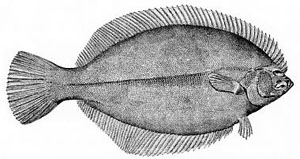Winter flounder facts for kids
Quick facts for kids Winter flounder |
|
|---|---|
 |
|
 |
|
| Scientific classification | |
| Synonyms | |
|
The winter flounder (Pseudopleuronectes americanus) is a special type of flatfish. People sometimes call it the black back. It's known for having both of its eyes on the right side of its body. This fish lives in the coastal waters of the western Atlantic Ocean. You can find it from Labrador, Canada all the way down to Georgia, United States.
Winter flounder are very common in shallow waters. They are often seen from Newfoundland down to Massachusetts Bay. These fish can grow quite large. Some reach about 61 centimeters (2 feet) long and weigh up to 2.25 kilograms (5 pounds). On Georges Bank, they can grow even bigger. There, they might reach 70 centimeters (2.3 feet) and weigh 3.6 kilograms (8 pounds). In the past, many people fished for winter flounder. However, their numbers have gone down since the 1980s.
Contents
Life Cycle of the Winter Flounder
Winter flounder lay many eggs, sometimes up to 3.3 million! These eggs stick to the bottom of the ocean where they are laid. They stay in their spawning grounds, which are special places where fish lay eggs.
After about two to three weeks, tiny larvae hatch from the eggs. These larvae are only about 3 millimeters long. At first, they float around in the water. But over time, they start to live closer to the seafloor.
About five to six weeks after hatching, something amazing happens. The left eye of the baby flounder starts to move! It slowly shifts over to the right side of its body. Once both eyes are on one side, they look like adult flounder. These young fish are called juveniles. They then settle onto the seafloor. They move into calm areas like saltwater coves and protected bays. Here, they can grow up to 100 millimeters (4 inches) in their first year.
Adult winter flounder can live for a long time. Some can reach over 15 years old. They can also grow as large as 70 centimeters (2.3 feet). Fish in colder northern areas usually grow slower than those in warmer southern areas.
Winter Flounder Family Tree
The winter flounder belongs to a group of fish called Pseudopleuronectes. There are five different species in this group. The other four are the Yellow-striped flounder, Cresthead flounder, Marbled flounder, and Dark flounder. The winter flounder is the only one of these five that lives in the Atlantic Ocean.
It's easy to tell a winter flounder apart from a summer flounder. Summer flounder are another common type of flatfish. Winter flounder have small teeth. Their eyes are almost always on the right side of their bodies. Summer flounder, however, have their eyes on the left side. They also have large, easy-to-see teeth.
What Winter Flounder Eat
Baby winter flounder, called larvae, eat tiny things. They munch on small creatures like nauplii and copepods. They also eat tiny worms and even some plant-like organisms. As they get bigger, their diet changes. They start to eat more copepods, amphipods (small shrimp-like creatures), and polychaetes (a type of worm).
Adult winter flounder are smart eaters. They look for food and eat what's available. They often eat worms, crustaceans (like crabs and shrimp), and clams. Sometimes, they even eat other small fish. They are always on the lookout for their next meal!
Reproduction of Winter Flounder
Winter flounder are ready to have babies when they are about two to three years old. At this age, they are usually 25–30 centimeters (10–12 inches) long. The exact age and size can be different depending on where they live.
Adult flounder usually move around a lot to reproduce. In late fall and early spring, they swim into shallow bays. They lay their eggs there in late winter or early spring. After laying eggs, they go back to deeper parts of the bay or out into the ocean.
Sometimes, these fish might not migrate. They might stay in shallow waters all year. This happens if the water stays cool (15°C or lower). It can also happen if there is plenty of food nearby. Scientists have studied winter flounder populations. They found that fish from different areas, like the Gulf of Maine and Georges Bank, usually don't mix much.
Fishing for Winter Flounder
Many people enjoy eating winter flounder. Their meat is white and tasty. In the U.S., they are sometimes called "lemon sole." In the past, a lot of winter flounder were caught. People fished for them for business (commercial fishing) and for fun (recreational fishing). At their peak, commercial fishers caught over 40 million pounds. Recreational fishers caught over 16 million pounds.
However, the number of flounder caught has gone down a lot since the 1980s. By 2013, commercial catches were only 6 million pounds. Recreational catches were just 77,000 pounds.
Scientists manage winter flounder in three main groups in U.S. waters. These groups are Southern New England/Mid-Atlantic, Georges Bank, and Gulf of Maine.
- The Southern New England/Mid-Atlantic group has been overfished. This means too many fish were caught, and their numbers are low. But now, people are not catching too many.
- The Georges Bank group is doing well. They are not overfished, and people are not catching too many.
- For the Gulf of Maine group, scientists don't know if they are overfished. But people are not catching too many of them right now.
Even with efforts to manage fishing, winter flounder still face problems. Their homes (habitats) are being damaged. This is called habitat degradation. There has also been a lot of fishing pressure. Plus, they have low genetic variability, which means they are less able to adapt. Climate change might also be making it harder for these fish to recover.

